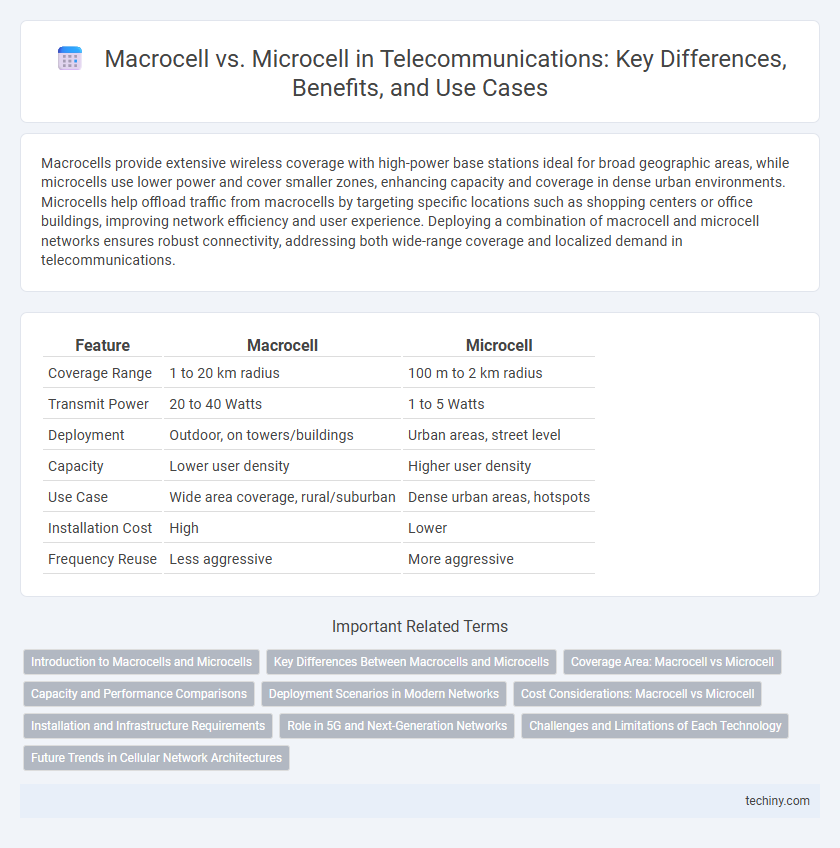Macrocells provide extensive wireless coverage with high-power base stations ideal for broad geographic areas, while microcells use lower power and cover smaller zones, enhancing capacity and coverage in dense urban environments. Microcells help offload traffic from macrocells by targeting specific locations such as shopping centers or office buildings, improving network efficiency and user experience. Deploying a combination of macrocell and microcell networks ensures robust connectivity, addressing both wide-range coverage and localized demand in telecommunications.
Table of Comparison
| Feature | Macrocell | Microcell |
|---|---|---|
| Coverage Range | 1 to 20 km radius | 100 m to 2 km radius |
| Transmit Power | 20 to 40 Watts | 1 to 5 Watts |
| Deployment | Outdoor, on towers/buildings | Urban areas, street level |
| Capacity | Lower user density | Higher user density |
| Use Case | Wide area coverage, rural/suburban | Dense urban areas, hotspots |
| Installation Cost | High | Lower |
| Frequency Reuse | Less aggressive | More aggressive |
Introduction to Macrocells and Microcells
Macrocells provide broad wireless coverage by utilizing high-power base stations typically mounted on towers or rooftops, enabling communication over several kilometers. Microcells operate at lower power, covering smaller areas such as urban centers, office buildings, or shopping malls, and effectively reduce network congestion by increasing capacity in dense locations. Both macrocells and microcells are integral components of cellular networks, working together to optimize coverage and improve overall signal quality.
Key Differences Between Macrocells and Microcells
Macrocells provide wide-area coverage with high transmission power, typically ranging from 20 to 40 watts, supporting large populations and extensive geographic regions. Microcells operate at lower power levels, usually under 5 watts, designed to enhance capacity and coverage in densely populated urban areas or indoor environments. Key differences include coverage radius, power consumption, and deployment cost, with macrocells ideal for broad coverage and microcells optimized for capacity and localized connectivity.
Coverage Area: Macrocell vs Microcell
Macrocells provide extensive coverage areas typically ranging from 1 to 20 kilometers, making them ideal for wide-area network support in rural or suburban environments. Microcells cover smaller regions, usually within 200 meters to 2 kilometers, optimizing network capacity and signal quality in dense urban or indoor locations. The choice between macrocell and microcell deployment directly impacts network scalability, signal penetration, and user experience in telecommunications infrastructure.
Capacity and Performance Comparisons
Macrocells provide extensive coverage areas with moderate capacity, suitable for wide geographic regions, while microcells offer higher capacity and improved performance in densely populated urban environments by serving smaller localized areas. Microcells reduce signal interference and enhance data throughput through increased frequency reuse and lower path loss, which boosts network efficiency and user experience. The choice between macrocells and microcells hinges on balancing coverage requirements against the demand for higher data rates and capacity in specific zones.
Deployment Scenarios in Modern Networks
Macrocell deployments dominate wide-area coverage in urban and rural regions, providing extensive signal reach and high capacity for mobile users over several kilometers. Microcells are strategically deployed in dense urban environments, stadiums, or commercial complexes to enhance capacity, reduce interference, and improve indoor coverage within smaller geographic areas typically under a few hundred meters. Modern 5G networks leverage a hybrid approach, integrating macrocells for broad connectivity and microcells to address high-traffic hotspots, enabling optimized network performance and user experience.
Cost Considerations: Macrocell vs Microcell
Macrocell systems typically incur higher infrastructure and maintenance costs due to larger coverage areas and more powerful equipment requirements. In contrast, microcells offer lower deployment expenses, making them cost-effective for densely populated urban environments with high user densities. Cost efficiency improves with microcells as they reduce the need for expensive macrocell towers while addressing capacity demands.
Installation and Infrastructure Requirements
Macrocell installation requires substantial infrastructure, including tall towers or rooftop antennas to cover extensive geographic areas, often necessitating zoning permits and robust power supplies. Microcell deployment involves smaller, low-power base stations installed on street furniture or building walls, demanding less space and simpler infrastructure but closer cell site density to ensure coverage. Both systems rely on backhaul connectivity; however, macrocells typically integrate with fiber optics or microwave links, whereas microcells may utilize wireless or Ethernet connections depending on urban density and network design.
Role in 5G and Next-Generation Networks
Macrocells provide wide-area coverage and high-capacity backbone support essential for 5G network infrastructure, enabling seamless connectivity across urban and rural environments. Microcells complement macrocells by offering localized, high-density coverage to manage network traffic in hotspots and indoor areas, enhancing user experience with low latency and higher data rates. Together, macrocells and microcells form a heterogeneous network architecture critical for optimizing spectrum usage, improving network efficiency, and supporting high-bandwidth applications in next-generation 5G deployments.
Challenges and Limitations of Each Technology
Macrocells face challenges such as interference management in densely populated urban areas and higher deployment costs due to large-scale infrastructure requirements. Microcells, while improving coverage and capacity in small geographic zones, encounter limitations including limited range, increased handoff frequency, and potential interference with neighboring cells. Both technologies must address spectrum allocation constraints and network planning complexities to optimize performance and user experience.
Future Trends in Cellular Network Architectures
Future trends in cellular network architectures emphasize the integration of macrocells and microcells to enhance coverage, capacity, and energy efficiency. Macrocells provide wide-area coverage with high power, while microcells serve densely populated urban areas with low power and higher data rates. Advanced technologies such as 5G and beyond leverage heterogeneous networks (HetNets) combining macrocells, microcells, small cells, and massive MIMO to optimize spectrum utilization and support massive IoT connectivity.
Macrocell vs Microcell Infographic

 techiny.com
techiny.com